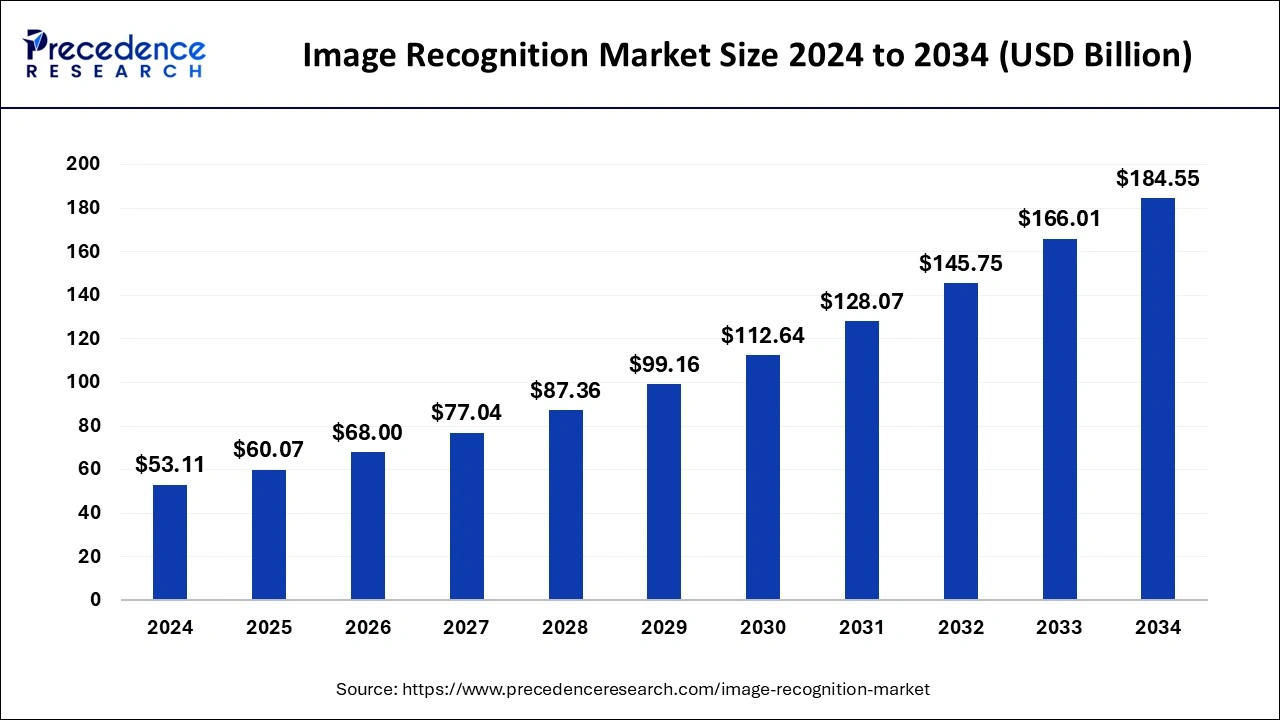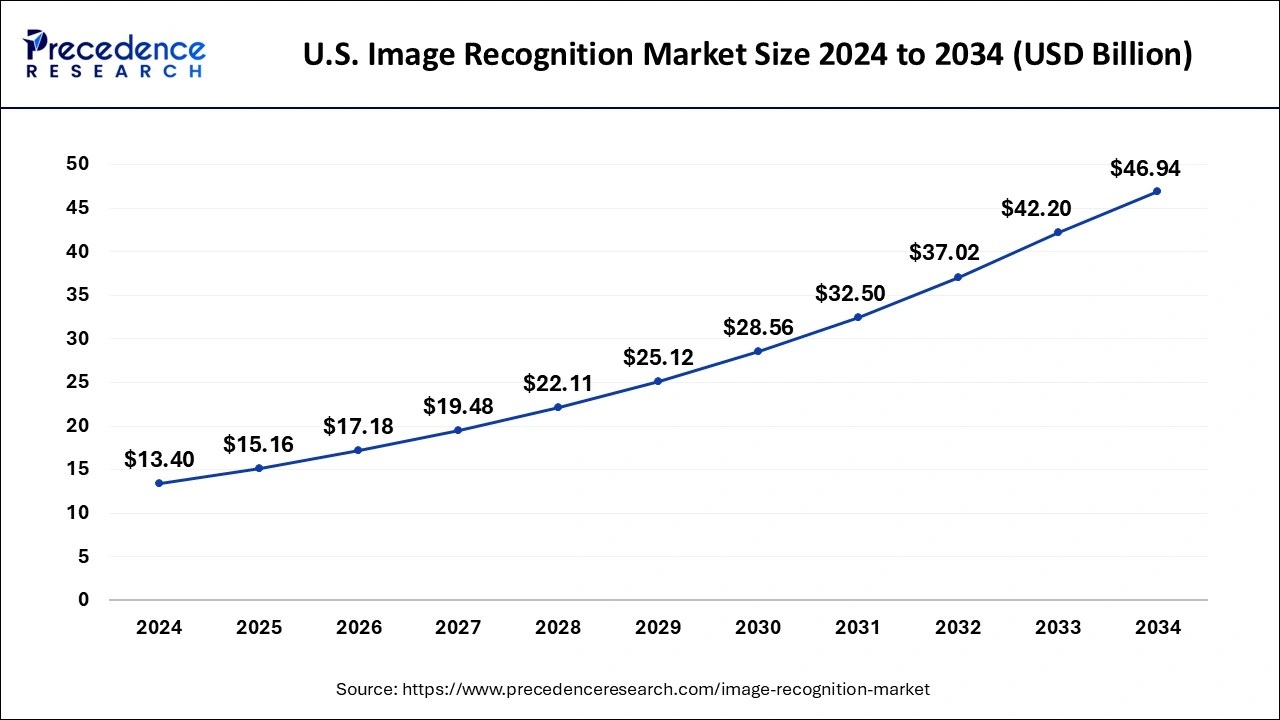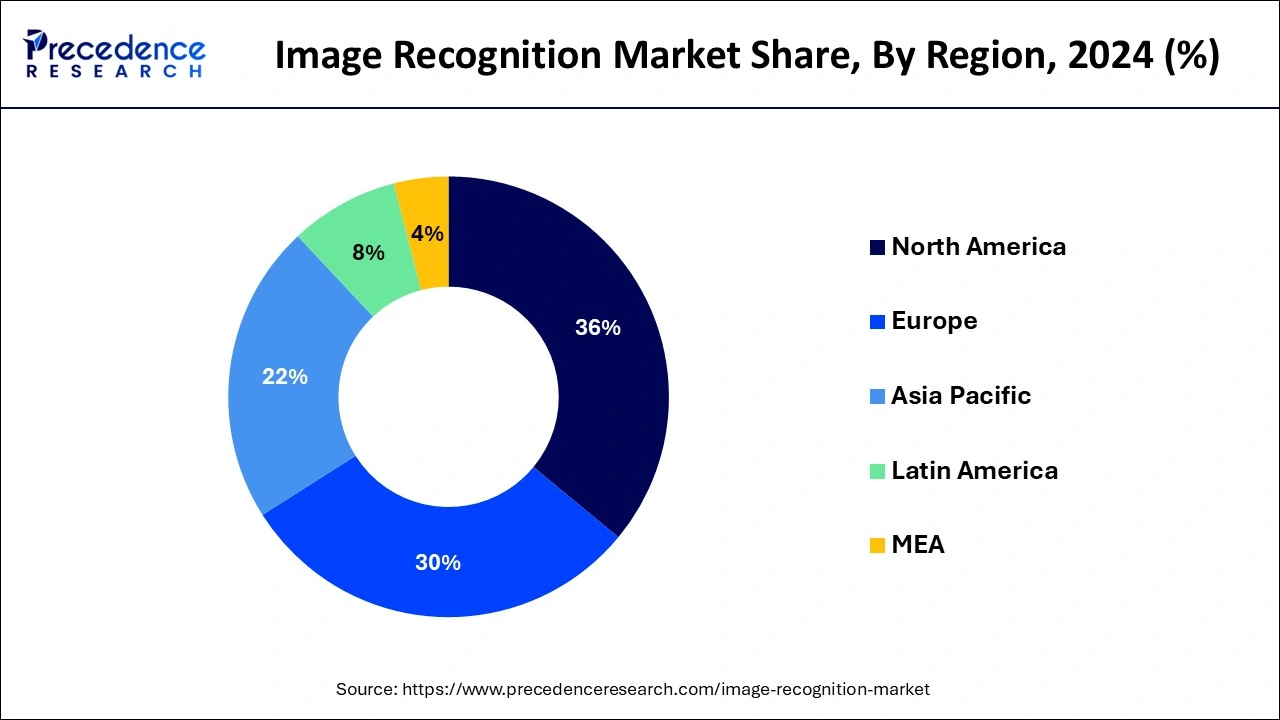March 2025
The global image recognition market size is calculated at USD 60.07 billion in 2025 and is forecasted to reach around USD 184.55 billion by 2034, accelerating at a CAGR of 13.26% from 2025 to 2034. The North America image recognition market size surpassed USD 19.12 billion in 2024 and is expanding at a CAGR of 13.29% during the forecast period. The market sizing and forecasts are revenue-based (USD Million/Billion), with 2024 as the base year.
The global image recognition market size was estimated at USD 53.11 billion in 2024 and is predicted to increase from USD 60.07 billion in 2025 to approximately USD 184.55 billion by 2034, expanding at a CAGR of 13.26% from 2025 to 2034.

The U.S. image recognition market size was valued at USD 13.40 billion in 2024 and is expected to reach around USD 46.94 billion by 2034, growing at a CAGR of 13.36% from 2025 to 2034.

North America held the largest market share of 36% in 2024 due to factors such as advanced technological infrastructure, high adoption of emerging technologies, and robust investments in research and development. The region's key role in industries like healthcare, retail, and automotive has driven the demand for image recognition applications. Additionally, the presence of major market players and a tech-savvy consumer base contribute to North America's leadership. Favorable government initiatives and a focus on innovation further solidify the region's dominant position in the global image recognition market.

Asia-Pacific is poised for rapid growth in the image recognition market due to a combination of increasing technology adoption, a burgeoning e-commerce landscape, and rising investments in artificial intelligence. With countries like China and India leading the way, there's a surge in demand for image recognition applications in retail, healthcare, and smart city initiatives. The region's robust economic growth, coupled with a focus on technological advancements, positions Asia-Pacific as a key market for the expanding applications of image recognition technologies.
Meanwhile, Europe is experiencing notable growth in the image recognition market due to increasing adoption across various industries. The region is witnessing rising demand in sectors such as retail, healthcare, and automotive, driven by advancements in artificial intelligence and deep learning. Stricter data privacy regulations in Europe are also fostering the implementation of on-premises image recognition solutions. Additionally, the region's emphasis on smart city initiatives, security applications, and innovation in retail experiences contribute to the expanding market, making Europe a significant player in the image recognition lands.
Image recognition is a technology that allows computers to understand and interpret visual information from images or photographs. It works by using advanced algorithms and pattern-matching techniques to identify and categorize objects, scenes, or people within an image. This technology mimics human visual perception, enabling machines to "see" and comprehend the content of pictures. Image recognition finds applications in various fields, such as facial recognition for security, product identification in retail, and medical image analysis in healthcare. It plays a vital role in enhancing automation, making processes more efficient, and powering innovations like augmented reality and autonomous vehicles by enabling machines to make decisions based on visual data.
| Report Coverage | Details |
| Growth Rate from 2025 to 2034 | CAGR of 13.26% |
| Market Size in 2025 | USD 60.07 Billion |
| Market Size by 2034 | USD 184.55 Billion |
| Largest Market | North Ameica |
| Base Year | 2024 |
| Forecast Period | 2025 to 2034 |
| Segments Covered | By Technique, By Application, By Component, and By Deployment Mode |
| Regions Covered | North America, Europe, Asia-Pacific, Latin America, and Middle East & Africa |
Advancements in artificial intelligence (AI) and deep learning
Advancements in artificial intelligence (AI) and deep learning have significantly boosted the demand for image recognition technology. AI and deep learning empower computers to understand images in a way that resembles human perception. By using complex algorithms and patterns, machines can now recognize and interpret visual data more accurately. This surge in accuracy has expanded the applications of Image Recognition across various industries. In simpler terms, as AI and deep learning technologies get smarter, image recognition becomes more powerful and versatile. This growth is seen in everyday technologies like facial recognition on our phones, helping in security, or in retail where AI can identify products. The increased capability of machines to "see" and understand images is driving the adoption of image recognition, making it an essential component in sectors ranging from healthcare to automotive, contributing to the overall growth and demand in the market.
Ethical and bias issues
Ethical and bias issues present significant restraints for the image recognition market, impacting its demand and adoption. One major concern revolves around the potential biases embedded in image recognition algorithms, leading to discriminatory outcomes. These biases can result from the algorithms being trained on datasets that may not be representative, causing disparities in recognition accuracy across different demographics. For example, studies have shown that facial recognition systems can exhibit higher error rates for certain ethnicities and genders, raising ethical questions about fairness and equality.
Moreover, the use of image recognition in sensitive areas like law enforcement and hiring processes has sparked debates about privacy invasion and potential violations of individual rights. Instances of wrongful arrests and biased decision-making further intensify these ethical concerns. As a result, businesses and organizations are facing pressure to address these issues responsibly, implement transparent practices, and actively work towards mitigating biases in image recognition systems. The ethical considerations surrounding image recognition play a crucial role in shaping public perception and regulatory attitudes, influencing the market demand as stakeholders increasingly prioritize fair and unbiased technological solutions.
Retail innovation
Retail innovation is creating significant opportunities for the image recognition market, transforming the way businesses interact with customers and manage operations. Image recognition plays a pivotal role in revolutionizing the retail sector by enabling innovative solutions such as cashier-less stores, where customers can make purchases without traditional checkouts. This not only enhances the shopping experience but also improves operational efficiency. Additionally, image recognition facilitates personalized advertising and recommendation systems, allowing retailers to tailor promotions based on individual preferences and purchase history, contributing to increased customer engagement and loyalty.
Moreover, the adoption of smart shelves, equipped with image recognition technology, provides real-time inventory tracking and product information. This not only streamlines inventory management but also minimizes out-of-stock situations and enhances the overall supply chain efficiency. As retailers increasingly seek ways to stay competitive and enhance customer satisfaction, the opportunities for image recognition in retail innovation continue to expand, offering solutions that drive efficiency, improve customer experiences, and ultimately contribute to business growth.
The facial recognition segment held the highest market share of 23% in 2024. Facial recognition is a technique within the image recognition market that involves identifying and verifying individuals based on unique facial features. This segment is witnessing a growing trend in security applications, such as access control and surveillance. The technology is becoming more prevalent in mobile devices for user authentication and is increasingly utilized in public spaces. Advances in facial recognition algorithms and hardware are enhancing accuracy, contributing to its widespread adoption across various industries for both convenience and security purposes.
The pattern recognition segment is anticipated to witness rapid growth at a significant CAGR of 14.8% during the projected period. Pattern recognition is a technique within the Image Recognition market that involves identifying patterns or features in visual data. This segment focuses on algorithms that enable machines to recognize specific patterns, objects, or behaviors within images. A notable trend in pattern recognition is the increasing use of machine learning, particularly deep learning algorithms, which enhances the accuracy and efficiency of pattern identification. This trend contributes to the continuous improvement of image recognition systems, making them more adept at recognizing complex patterns and enhancing their application in various industries.
The marketing and advertising segment has held a 30% market share in 2024. In the image recognition market, the marketing and advertising segment refers to the application of image recognition technology in enhancing promotional strategies. This involves analyzing visual content for targeted advertising, personalized marketing campaigns, and interactive experiences. A notable trend in this segment is the use of image recognition for visual search and augmented reality (AR) applications, allowing consumers to engage with products in real-time. Marketers leverage image recognition to create more engaging and tailored content, fostering a dynamic and interactive connection between brands and consumers in the evolving landscape of digital marketing.
The augmented reality segment is anticipated to witness rapid growth over the projected period. The augmented reality (AR) segment in the image recognition market refers to the integration of image recognition technology into AR applications, creating immersive experiences. This involves recognizing real-world objects or scenes and overlaying digital content in real-time, enhancing user interactions. A key trend in this segment is the rising demand for AR applications across gaming, advertising, and education. Image recognition in AR is evolving to offer more seamless and interactive experiences, driving innovation in various industries and opening new avenues for engaging and immersive content delivery.
The service segment has held a 39% market share in 2024. In the image recognition market, the service segment encompasses a range of offerings that support the implementation, integration, and maintenance of image recognition solutions. Services include system integration, training and consulting, and ongoing technical support. Trends in this segment indicate a growing demand for specialized services, such as custom algorithm development, to address unique business needs. Additionally, the rising importance of ethical considerations has led to increased demand for services focused on bias mitigation and transparent deployment of image recognition technologies, ensuring responsible and fair implementations.
The software segment is anticipated to witness rapid growth over the projected period. In the image recognition market, the software segment refers to the programs and algorithms responsible for processing and analyzing visual data. These software components play a crucial role in enhancing image recognition accuracy and capabilities. Current trends in image recognition software include the integration of advanced machine learning algorithms, deep neural networks, and cloud-based solutions. Ongoing developments focus on improving real-time processing speed, reducing false positives, and addressing ethical concerns related to bias in image recognition systems, ensuring more accurate and fair results.
The cloud segment has held a 71% market share in 2024. In the image recognition market, the cloud deployment mode involves hosting image recognition solutions on remote servers accessed via the Internet. Cloud-based image recognition offers scalability, accessibility, and cost-effectiveness, allowing businesses to leverage powerful processing capabilities without the need for extensive on-premises infrastructure. A prominent trend in this segment is the increasing adoption of cloud services for image recognition, enabling real-time processing, improved collaboration, and seamless integration with other cloud-based applications, fostering agility and innovation in diverse industries.
The on-premises segment is anticipated to witness rapid growth over the projected period. On-premises deployment in the image recognition market refers to the installation of image recognition systems within an organization's physical infrastructure. This deployment mode provides businesses with direct control over data and security. A notable trend in the on-premises segment is the preference for this deployment mode in industries with stringent data privacy regulations, like healthcare and finance. Companies are opting for on-premises solutions to ensure data control, compliance, and security, reflecting a growing demand for localized and secure image recognition implementations.
By Technique
By Application
By Component
By Deployment Mode
By Geography
For inquiries regarding discounts, bulk purchases, or customization requests, please contact us at sales@precedenceresearch.com
No cookie-cutter, only authentic analysis – take the 1st step to become a Precedence Research client
March 2025
October 2024
March 2025
July 2024